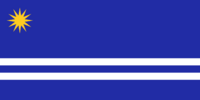Khirmania: Difference between revisions
Jump to navigation
Jump to search
No edit summary |
No edit summary |
||
| Line 13: | Line 13: | ||
|Leader_title1 = Supreme Lord of the Realm | |Leader_title1 = Supreme Lord of the Realm | ||
|Leader_name1 = Dakhila II | |Leader_name1 = Dakhila II | ||
|Legislature = Parliament | |Legislature = Parliament | ||
|currency = Khirmanian Dollar | |currency = Khirmanian Dollar | ||
| Line 61: | Line 59: | ||
=Economy= | =Economy= | ||
Khirmania is a highly developed capitalist mixed economy. Up until the late 1960s, the nation was mostly an agrarian society. | |||
==Infastructure== | ==Infastructure== | ||
Revision as of 10:24, 29 December 2022
The Holy State of Khirmania | |
|---|---|
|
Flag | |
| Motto: May the Gods bless us | |
| Capital | Mukada |
| Official languages | Khirmani, Common |
| Ethnic groups | 89% Khirmani 11% others |
| Demonym(s) | Khirmanian |
| Government | Unitary theocratic constitutional elective monarchy |
| Population | |
• 2021 estimate | 12.7 million |
| Currency | Khirmanian Dollar |
Khirmania, officially the Holy State of Khirmania, is a sovereign nation located in Thrismari and is bordered by Salamat to the southwest and Sontaro to the east.
History
Pre-history
13th century to Riamese colonisation
The Great War
Independent Nation and Bati I
21st Century
Geography
Climate
Biodiversity
Government and Politics
Supreme Lord of the Realm
The Supreme Lord of the Realm, unofficially called the King of Khirmania, is the head of state and highest religious official of Khirmania
Prime Minister
Parliament
Law
Foreign Relations
Military
Economy
Khirmania is a highly developed capitalist mixed economy. Up until the late 1960s, the nation was mostly an agrarian society.
